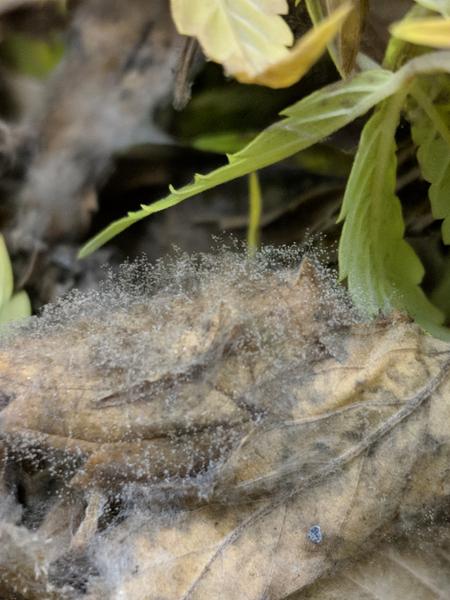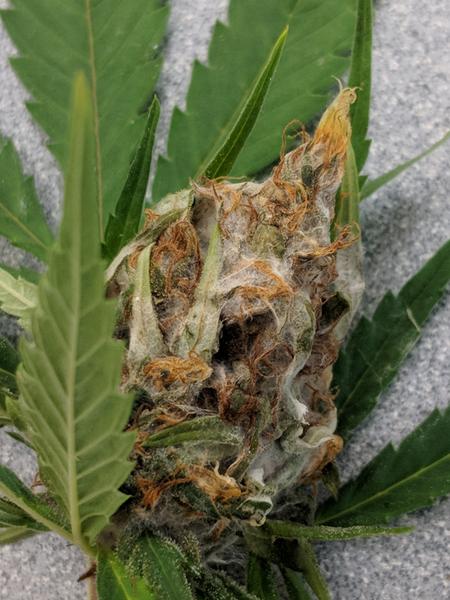Introduction
Gray mold is a common problem for many food crops produced in North Carolina. Because it has a wide host range, crop rotation strategies may not be effective. This disease is most commonly found in greenhouse production, and when plants are in cool, wet conditions. Occasionally, this pathogen is present in field produced hemp when environmental conditions favor its development; however, it is often not found in outdoor hemp in NC. This disease can affect all parts of the plant, causing damages to leaves, stems, flowers, and roots.
Pathogen
Gray mold is caused by Botrytis cinerea (teliomorph Botryotinia fuckeliana), which is a necrotrophic fungus that can cause severe damages to industrial hemp. B. cinerea produces several cell wall-degrading enzymes and toxins that degrade tissues and can also infect plant wounds caused by insects or pruning.
The fungus produces gray-white masses of mycelium (fungal mats) and spores on the surface of affected tissues (Figure 1). As tissues become decayed, the pathogen forms sclerotia (fungal overwintering structures) that are black, irregularly-shaped structures and mimic rodent droppings.
Host Range
B. cinerea affects over 200 plant species, including vegetables, peanut, strawberry, grape, and ornamentals. Economic losses may be found in both field and greenhouse production, and crops can suffer losses at almost any growth stage, including postharvest.
Symptoms
Gray mold can cause brown, water-soaked lesions on all portions of the plant, including stems, leaves, and flowers. Leaves and flower lesions eventually become necrotic and produce a mass of gray spores (Figure 1). When stems/branches are infected, lesions may girdle the stem and cause limb or stalk breakage. Similarly to leaf and flower infections, necrotic tissues may be covered with a mat of gray spores. Within stem tissues, black sclerotia may develop.
Botrytis cinerea may also cause damping off of small seedlings or cuttings in the greenhouse when conditions are cool and wet. plants may girdle at the soil line and roots become necrotic and water-soaked.
Diseases With Similar Symptoms
Fusarium Flower Mold (Fusarium graminearm complex, Figure 2)
This pathogen can have similar appearance on leaves and flowers. The two pathogens can be distinguished under conducive conditions by the absence of the gray spore mats produced by B. cinerea.
Fusarium Stem Canker (Fusarium graminearum complex, Figure 3)
Stem canker caused by the Fusarium graminearum complex can also cause necrotic stem lesions and girdling. This fungus does not produce gray spores on the surface of lesions and does not produce sclerotia.
Hemp Canker (Sclerotinia sclerotiorum)
This stem canker is characterized by shredding and breaking of stems at the lesion and the presence of white fungal mats with black, irregularly-shaped sclerotia inside of the lesion. This pathogen does not produce gray spores.
Disease Cycle
This fungus overwinters as sclerotia in plant debris or in soil. Under conducive conditions, sclerotia germinate to form hyphal mats and the production of conidia (spores) on conidiophores. Conidia are dispersed in wind or water splash and land on a new host. Spores germinate and form new infections of any part of the plant, including leaves, stems, and flowers. As the tissues are depleted of resources, the fungus forms sclerotia to overwinter until favorable conditions are present.
Favorable Conditions for Disease
Temperatures between 65-75°F [18-24°C], coupled with moist or humid conditions, are most conducive to the growth and dispersal of B. cinerea. As a result, most crops will suffer from infections in the late winter and early spring. These conditions may also be found in greenhouse conditions year-round, and altering the greenhouse environment to limit suitable conditions may be necessary to prevent disease.
General Management
Gray mold can be difficult to control because it has a wide host range and can survive for extended periods of time in the absence of a host as sclerotia. A single mode of prevention alone is unlikely to be successful in preventing gray mold.
Sanitation is an important component to preventing spread of gray mold. Clean all equipment used on/near plants. Removing dead and infected plants and plant parts is essential to preventing, slowing, and stopping the spread of infection. Avoid removing affected plant parts when the field is wet or humid to prevent the spread of spores in conditions that favor further infection. Proper spacing will promote air flow between and around plants, also reducing the risk of infection. Because B. cinerea thrives in cool, moist environments, maintaining a properly watered environment with as little excess moisture as possible should reduce epidemics. Reduce humidity (below 50% RH) in greenhouses. Avoid over-fertilization to limit excess growth of the plant.
There are currently no effective, legal chemistries available to control gray mold in industrial hemp.
Useful Resources
- The NC State University Plant Disease and Insect Clinic provides diagnostics and control recommendations.
- The NC State Extension Plant Pathology Portal provides information on crop disease management.
- The NC State Industrial Hemp Portal provides updates for industrial hemp management and production in North Carolina.
- The North Carolina Agricultural Chemicals Manual provides pesticide information for common diseases of North Carolina. The manual recommendations do not replace those described on the pesticide label, and the label must be followed.
- For assistance with a specific problem, contact your N.C. Cooperative Extension agent.
Acknowledgements
This factsheet was prepared by the NC State University Field Crops and Tobacco Pathology Lab in 2019.
- Check out our Facebook and our Twitter!
Publication date: Sept. 9, 2019
Reviewed/Revised: June 18, 2024
The use of brand names in this publication does not imply endorsement by NC State University or N.C. A&T State University of the products or services named nor discrimination against similar products or services not mentioned.
Recommendations for the use of agricultural chemicals are included in this publication as a convenience to the reader. The use of brand names and any mention or listing of commercial products or services in this publication does not imply endorsement by NC State University or N.C. A&T State University nor discrimination against similar products or services not mentioned. Individuals who use agricultural chemicals are responsible for ensuring that the intended use complies with current regulations and conforms to the product label. Be sure to obtain current information about usage regulations and examine a current product label before applying any chemical. For assistance, contact your local N.C. Cooperative Extension county center.
N.C. Cooperative Extension prohibits discrimination and harassment regardless of age, color, disability, family and marital status, gender identity, national origin, political beliefs, race, religion, sex (including pregnancy), sexual orientation and veteran status.



